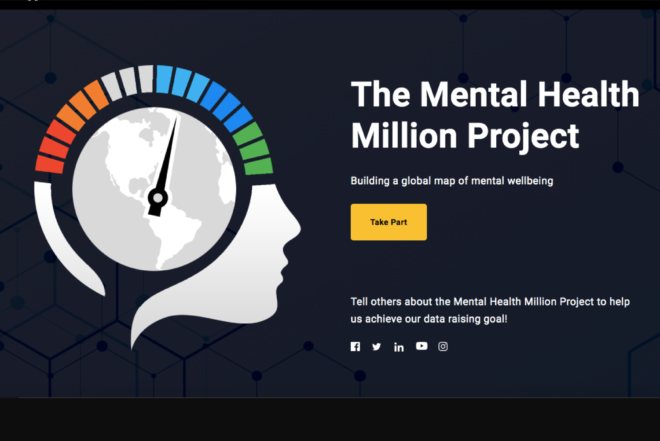The Mental Health Million Project seeks to create an evolving map of global mental wellbeing and its demographic and situational drivers.
As a global population, we exhibit a huge diversity in our state of mental health and wellbeing. Although there is some data on the prevalence of disorders like depression, anxiety and addiction (see Our World in Data) that provide an indication of how many people are suffering from serious challenges to their mental health, there is currently no big picture understanding of the overall mental wellbeing of our global population.
The recently launched Mental Health Million Project seeks to build an evolving map of Global Mental Wellbeing and insights into its key drivers. In particular it looks to understand what our overall mental wellbeing looks like by different geographies and demographics as well as provide insight into drivers of mental health risks. It will also specifically assess the impacts of Covid-19 on mental wellbeing
The benefit of understanding population wellbeing is two-fold. Firstly, you can identify at risk groups or populations most in need of care and support. Secondly, by delving a bit deeper, you can start to untangle the multiple risk and protective factors which underpin why some subgroups and populations have lower mental wellbeing than others. What is it about their experiences or environment that might be playing a role? And by addressing these at the level of policy or community level interventions, you have the ability not only to change the mental wellbeing of people on an individual level but the potential to induce large-scale shifts in population wellbeing which could benefit the lives of hundreds, thousands or millions of people.
What does it mean to be mentally well?
A useful definition comes from the World Health Organization (WHO) [1] that defines mental health as “a state of wellbeing in which the individual realizes his or her own abilities, can cope with the normal stresses of life, can work productively and fruitfully, and is able to make a contribution to his or her community”.
Fundamentally mental wellbeing is not the same as happiness or life satisfaction. Rather it is the mental capacity to handle and navigate life’s challenges effectively. Human life has always been rife with challenges from loss of loved ones and loss of employment to war and natural disasters. One can be deeply saddened or dissatisfied with life’s circumstances and yet mentally well. On the other hand, if certain mental or emotional capabilities spiral out of control preventing you from being a functioning member of society, this indicates something more serious.
Achieving mental wellbeing depends on a whole host of cognitive, emotional, social and physical functions that need to be operating in line with, or beyond, the demands of any situation you face. Cognitive functions like being flexible when faced with change, emotional functions like being able to regulate your emotions, and social functions like being able to build close relationships, to name a few. However, when one or more of these functions becomes impaired, our mental wellbeing suffers and, in the most extreme cases, symptoms of mental health disorders can start to arise,
Some of us are better equipped to handle life’s challenges than others and our mental wellbeing falls along a wide spectrum from clinically at risk to thriving. Measuring how the global population is distributed along this spectrum is key to understanding the border between mental health and ill-health, and the factors that influence why some people slide towards mental ill health.
A preliminary view
 Early validation studies (pre-Covid19) of the MHQ, the tool used in the Mental Health Million Project provides some preliminary hints. The MHQ is a comprehensive assessment of 47 dimensions of mental health symptoms and positive assets it assigns them to a level of mental wellbeing from “Clinical”, through to “Thriving”. In this set of about 2000 people, 14% of the population sampled were clinical or at risk, whilst only 10% were thriving. Data looking across different age brackets showed that those aged 18-24 had the lowest mental wellbeing (only 29% were thriving compared to 65% of those aged above 55), an alarming statistic that speaks to the growing crisis among young people today.
Early validation studies (pre-Covid19) of the MHQ, the tool used in the Mental Health Million Project provides some preliminary hints. The MHQ is a comprehensive assessment of 47 dimensions of mental health symptoms and positive assets it assigns them to a level of mental wellbeing from “Clinical”, through to “Thriving”. In this set of about 2000 people, 14% of the population sampled were clinical or at risk, whilst only 10% were thriving. Data looking across different age brackets showed that those aged 18-24 had the lowest mental wellbeing (only 29% were thriving compared to 65% of those aged above 55), an alarming statistic that speaks to the growing crisis among young people today.
Participating and Partnering in the Mental Health Million Project
To participate, it simply requires taking the MHQ online. It is anonymous, takes about 15 minutes and will provide you an overall mental wellbeing score on completion and, on request, a detailed email report. We welcome partnerships with all kinds of organizations and groups to help build the database across a wide range of demographics. If you have a particular group or community you would like to work with us to reach and assess, let us know.

